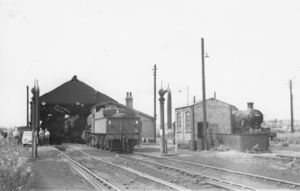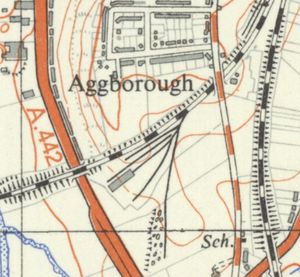Kidderminster Shed
Contents
Kidderminster Shed under GWR
Kidderminster was GWR shed number 125, code KDR, and was part of the Worcester division. The shed was situated on the south side of the line between Hoo Road Bridge and Worcester Road Bridge (on the left when travelling from Kidderminster towards Bewdley). It was built in 1932 under the Loans & Guarantees Act (1929) to replace the original smaller single-road GWR shed which was situated adjacent to Kidderminster mainline station.[1] The extract from Ordnance Survey Map SO87, surveyed 1938 - 1949, published 1951, shows the later location.
The structure which housed the locomotives was steel framed with corrugated sheeting, and was previously the 1921 engine shed from Basseleg, Newport on the Brecon and Merthyr Tydfil Junction Railway.[1] Along the side of the shed (to the right of the shed in the picture) was a row of brick built offices with a sloping slate roof which served as the Foreman’s office, stores, fitters’ shop, enginemen’s cabin and shed men’s rest room. Two water columns and pits served the two roads into the shed. The picture also shows a small sand furnace building to the right of the water column. The coaling stage was further to the right, out of sight in the picture.[2]
A snapshot in 1943 shows the following locomotives allocated to Kidderminster (GWR unless stated)[3]:
- Cleobury Mortimer and Ditton Priors Light Railway CMDP Class 0-6-0PT Nos 28, 29
- Dean 2021 Class 0-6-0PT No 2153
- Churchward 4575 Class 2-6-2T Nos 4586, 4596
- Collett 5700 Class 0-6-0PT No 4625, 8718, 8727
- Collett 5101 Class 2-6-2T Nos 5110, 5112
- Churchward 4575 Class 2-6-2T Nos 5518, 5538, 5573
- Collett 8100 Class 2-6-2T No 8101
- LNER J25 Class 0-6-0 Nos 2134, 2142, 2051, 1994
'Asleft', a fireman at Kidderminster between 1945 and 1949, described Kidderminster as "...a small but complete engine shed. The men working there were an example in miniature of the range and types of men found at larger depots". In addition to the drivers and firemen based there, there was a small workshop with a small fitting staff responsible for simple repairs such as adjusting brakes and repairing blown joints, although larger repairs such as the removal of pistons and valves were carried out elsewhere. One man was normally responsible for boiler washouts and working on the coal stage[4]. There were around 69 men based at the shed, comprising the Shed Foreman, approximately 25 sets of Footplate Men (drivers and firemen), 4 Fitters, 8 Cleaners, a Boiler Man, 4 Shed Men and a Clerk[5].
Kidderminster Shed under BR
Post-War, Kidderminster had 3 different shed numbers under BR. Following nationalisation, Kidderminster initially became BR shed code 85D on 1 February 1950, as part of the group under 85 Worcester. On 10 September 1960 it became Shed 84G under 84 Wolverhampton. Finally, in 1963 responsibility for the area was transferred from the Western Region to the London Midland Region, and on 1 September 1963 it became shed 2P under 2 Rugby.
The total number of engines allocated to Kidderminster Shed post-War, albeit not all at one time, were[6]:
| Company | Designer | Locomotive class | Wheel arrangement | Number allocated |
|---|---|---|---|---|
| GWR | Churchward | 4300 Class | 2-6-0 | 22 |
| GWR | Collett | 5700 Class | 0-6-0PT | 18 |
| GWR | Collett | 5101 Class | 2-6-2T | 13 |
| GWR | Collett | 4575 Class | 2-6-2T | 5 |
| GWR | Collett | 5600 Class | 0-6-2T | 3 |
| GWR | Dean | 2021 Class | 0-6-0PT | 3 |
| GWR | Collett | 1400 Class | 0-4-2T | 2 |
| GWR | Collett | 2251 Class | 0-6-0 | 2* |
| GWR | Collett | 6100 Class | 2-6-2T | 2 |
| GWR | Churchward | 4500 Class | 2-6-2T | 1 |
| GWR | Collett | 'Grange' 6800 Class | 4-6-0 | 1 |
| GWR | Dean | 'Bulldog' 3300 Class | 4-4-0 | 1 |
| GWR | Hawksworth | 1600 Class | 0-6-0PT | 1 |
| LMS | Stanier | 3P | 2-6-2T | 1 |
| BR | Riddles | Standard Class 3 Tank | 2-6-2T | 3 |
| BR | Diesel Class 08 | 0-6-0 | 1 |
During the 1950s the area covered by Kidderminster based locomotives included passenger/goods services on the Severn Valley Branch between Shrewsbury and Hartlebury, in some cases continuing south to Worcester and thence to Ledbury. Services on the Tenbury Branch to Woofferton also continued south to Leominster. Services north from Kidderminster worked via Stourbridge as far as Wolverhampton and also via Stourbridge to Birmingham and thence to Leamington Spa.[7]
Kidderminster shed closed on 10 August 1964, with the last 8 engines being transferred to nearby Stourbridge shed (84F) 2 days earlier. The last 8 engines at Kidderminster were:
- Collett 5700 Class 0-6-0PT Nos 3601, 3607, 3619, 8718
- Collett 5101 Class 2-6-2T Nos 4147, 4153, 4173, 4175
The area formerly occupied by Kidderminster Shed is now a housing estate.
Historic maps of Kidderminster Shed
- Original GWR map showing the engine shed and associated sidings as a later amendment.
- 1927 OS map showing the fence line extended and a single siding in the area where the shed was to be built.
- 1938 OS map showing the engine shed and a further siding extending in to gravel pits to the south. H. Whitehouse's Sand Siding is north of the Severn Valley Branch.
See also
References
- ↑ 1.0 1.1 Lyons (1972) p. 180.
- ↑ Barfield (1994) p. 21.
- ↑ Beddoes & Smith (1995) p. 136.
- ↑ 'Asleft' (1978), pp. 42--43.
- ↑ Turley (2005) p. 17.
- ↑ Kidderminster on BRDatabase.info
- ↑ Barfield (1994) p. 20.
Further reading
- No Steam Without Fire, 'Asleft' (1978), ISBN 0950053341 Memories of life on the footplate at Wolverhampton, Kidderminster, and Newton Abbot
- When There Was Steam, Tony Barfield (1994), ISBN 1-85648-190-5 Memories of a Western Region fireman based at Kidderminster Shed



